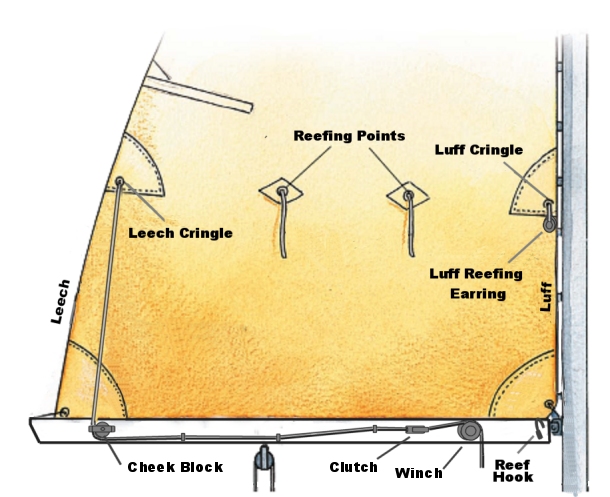The Blue View - Reefing
/Neptune has has been very good to us over the years. When we do something stupid or ill advised, he usually provides us a with a lesson to show us the error of our ways. These lessons almost always result in some embarrassment, frequently involve a short term adrenaline rush, and, on occasion, has resulted in some damage to the boat. Fortunately, he has helped us avoid any major catastrophes, and the damage to our egos was usually much greater then the damage to Nine of Cups.
One of his first lessons was on reefing the sails. This is a maneuver used to reduce the sail area when the wind increases (as opposed to the other kind of reef – the hard kind we bump into every once in awhile – that's another of Neptune's lessons for a future blog). We had only been on Cups for a couple of months and were heading up the east coast of Florida. Marcie had just brought dinner up to the cockpit when we saw a big squall heading our way. We had all our sails up, but surely we had enough time to eat our dinner and then reef down before it got to us. Ten minutes later, as our dinner plates scattered to the winds (literally) and we were hunkered down on the floor of the cockpit fearing for our lives, we learned Neptune's lesson about reefing and reefing early.
Since then, we always reef at the first sign of bad weather. On a long passage, we reef down just before dark each day as a precaution. We have streamlined our reefing technique and it now only takes a couple of minutes to add or let out a reef.
On Nine of Cups, we use a simple slab reefing system. Our main sail has three sets of reefs. The sketch only shows one reef, but our sail has two more sets of cringles and reefing points located higher up on the sail, as well as two more cheek blocks and rope clutches. We also have duplicates of the reefing lines, blocks, clutches and winch on the other side of the boom, so we can always reef on the windward side of the boat. Our procedure for reefing is slightly different depending on whether we are sailing into the wind or downwind. I will describe the process for the former first.
If the wind is coming from forward of the beam, reefing is quite simple. First, we remove the downward tension on the boom by slacking off on the vang and mainsheets. The aft end of the boom is raised a small amount by bringing the topping lift in a turn or two. Then the mainsail is lowered by letting out some of the main halyard. We have marks on the main halyard for each of the reefs, so we know just how much to let out.
One of us goes forward to the windward side of the mast and pulls the luff reefing earring down and hooks it over the reef hook. Next, the leech cringle is winched down until the cringle is close to the boom. Then the main halyard is tensioned, the boom tension is adjusted using the vang, and the mainsheet is trimmed. The whole maneuver usually takes less than five minutes (perhaps less for more agile sailors!).
If we are sailing downwind, the process is similar, but slower and more controlled. The mainsheet is cranked in, if necessary, until the boom is well away from the shrouds, and then the tension is removed from the vang. One of us, usually me, goes forward to the mast and pulls down on the luff while the sail is slowly lowered a foot or so. The leech cringle is then cranked in. The mainsail is lowered another foot or so while I continue to pull down on the luff and keep tension on the leech cringle. These steps are repeated, a foot at a time, until the luff reefing earring can be hooked over the reef hook. Once the earring is secured, the process is the same for downwind or upwind. With two of us, it usually takes about ten minutes to reef downwind. It can be done by one person, but the time would probably be doubled.
There are a lot of different methods and variations of these methods for reefing, all with pros and cons, but this is what works for us. Though I wouldn't ever consider us fast learners, Neptune has a way of making lessons stick vividly in our minds. We reef fast and early.



